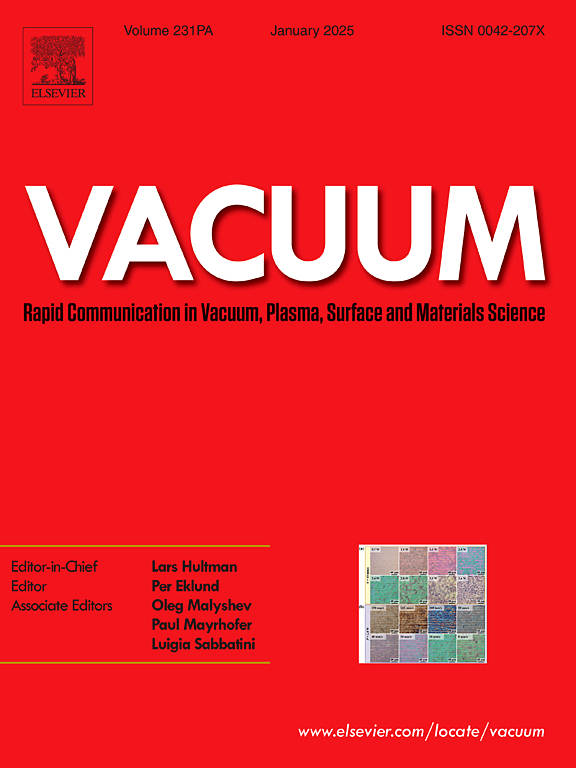基底类型对 HWP-CVD 沉积的垂直石墨烯纳米片的结构和电化学性能的影响
IF 3.8
2区 材料科学
Q2 MATERIALS SCIENCE, MULTIDISCIPLINARY
引用次数: 0
摘要
以 CH4/Ar 为前驱体,采用螺旋波等离子体化学气相沉积(HWP-CVD)方法在铜、钛、硅和碳基底上合成了垂直石墨烯纳米片(VGs)。扫描电子显微镜和 TEM 图像显示,获得的样品形成了纳米片石墨烯的垂直取向结构。具体来说,生长在铜基底上的石墨烯呈现平行排列,壁间距约为 450 nm。这种结构特征有利于形成高效的离子交换通道,并降低电子传输的阻力。讨论了衬底类型对 VG 生长机制的影响。研究了生长在不同基底上的 VG 的微观结构与电化学性能之间的关系。VGs/Cu 的电荷转移电阻为 20.75 Ω,VGs/Ti、VGs/C 和 VGs/Si 分别为 23.51 Ω、33.76 Ω 和 66.40 Ω。VGs 具有坚固的垂直取向结构,有望在燃料电池的催化剂支持、光伏电池的导电电极以及锂离子电池和超级电容器等储能设备中得到广泛应用。这种结构特征在推动下一代储能技术的发展方面发挥着举足轻重的作用。本文章由计算机程序翻译,如有差异,请以英文原文为准。
Effect of substrate type on structural and electrochemical performance of vertical graphene nanosheets deposited by HWP-CVD
Vertical graphene nanosheets (VGs) were synthesized on Cu, Ti, Si, and C substrates by helicon wave plasma chemical vapor deposition (HWP-CVD) method using CH4/Ar as precursors. The obtained samples formed vertical orientation structures of nanosheets-graphene as the scanning electron microscopy and TEM images indicated. Specifically, the VGs grown on Cu substrate exhibit a parallel arrangement with a wall spacing of approximately 450 nm. This structural characteristic facilitates efficient ion exchange channels and promotes low resistance for electron transport. The effect of substrate type on the growth mechanism of VGs was discussed. The relationship between the microstructure and electrochemical performance of the VGs grown on different substrates was investigated. The charge transfer resistance of the VGs/Cu is 20.75 Ω, and the value of VGs/Ti, VGs/C and VGs/Si are 23.51 Ω, 33.76 Ω and 66.40 Ω, respectively. The robust vertical orientation structure of VGs holds promise for various applications, including catalyst support in fuel cells, conductive electrodes in photovoltaic cells, and energy storage devices like lithium-ion batteries and supercapacitors. This structural characteristic plays a pivotal role in advancing the development of next-generation energy storage technologies.
求助全文
通过发布文献求助,成功后即可免费获取论文全文。
去求助
来源期刊

Vacuum
工程技术-材料科学:综合
CiteScore
6.80
自引率
17.50%
发文量
0
审稿时长
34 days
期刊介绍:
Vacuum is an international rapid publications journal with a focus on short communication. All papers are peer-reviewed, with the review process for short communication geared towards very fast turnaround times. The journal also published full research papers, thematic issues and selected papers from leading conferences.
A report in Vacuum should represent a major advance in an area that involves a controlled environment at pressures of one atmosphere or below.
The scope of the journal includes:
1. Vacuum; original developments in vacuum pumping and instrumentation, vacuum measurement, vacuum gas dynamics, gas-surface interactions, surface treatment for UHV applications and low outgassing, vacuum melting, sintering, and vacuum metrology. Technology and solutions for large-scale facilities (e.g., particle accelerators and fusion devices). New instrumentation ( e.g., detectors and electron microscopes).
2. Plasma science; advances in PVD, CVD, plasma-assisted CVD, ion sources, deposition processes and analysis.
3. Surface science; surface engineering, surface chemistry, surface analysis, crystal growth, ion-surface interactions and etching, nanometer-scale processing, surface modification.
4. Materials science; novel functional or structural materials. Metals, ceramics, and polymers. Experiments, simulations, and modelling for understanding structure-property relationships. Thin films and coatings. Nanostructures and ion implantation.
 求助内容:
求助内容: 应助结果提醒方式:
应助结果提醒方式:


